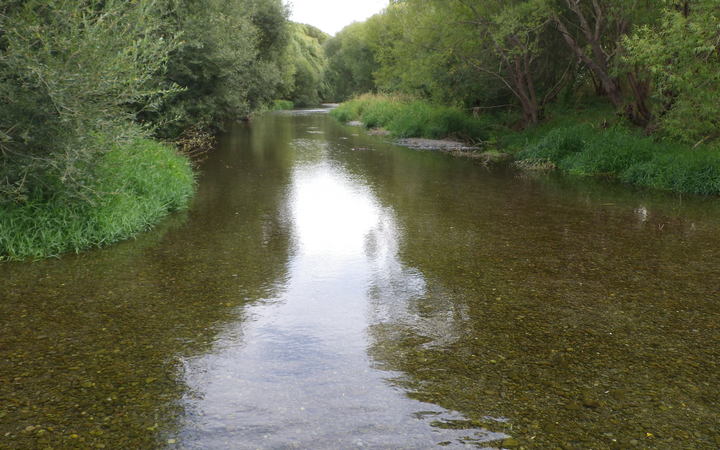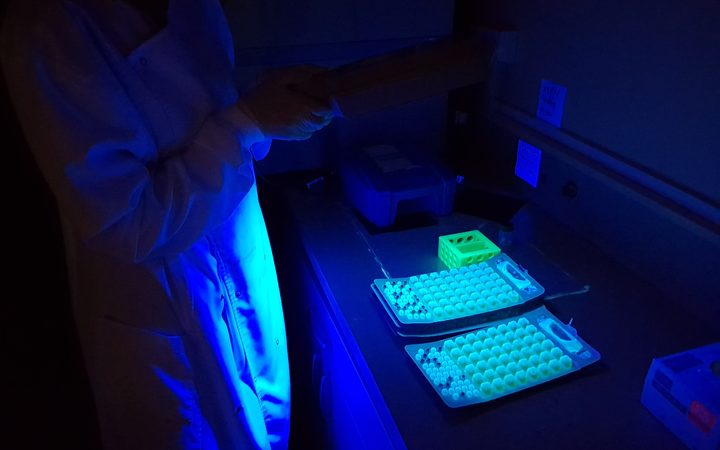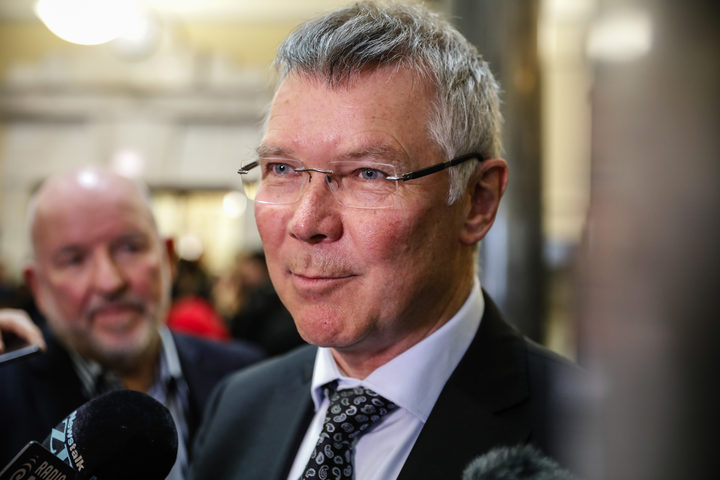When I was growing up these waters were pristine: we drank it, we swam in it
 The
Selwyn River was one of three tested in May and
September. Photo: Green Ideas editor Greg Roughan
The
Selwyn River was one of three tested in May and
September. Photo: Green Ideas editor Greg Roughan
 A
scientist uses white light to test for E. coli in
samples. Photo: RNZ/Kate Gudsell
A
scientist uses white light to test for E. coli in
samples. Photo: RNZ/Kate Gudsell
 Environment
Minister, David Parker says the ministry's Essential Freshwater
Taskforce is working towards making a 'noticeable difference' in
waterways. Photo: RNZ / Richard Tindiller
Environment
Minister, David Parker says the ministry's Essential Freshwater
Taskforce is working towards making a 'noticeable difference' in
waterways. Photo: RNZ / Richard Tindiller

Kidney
failure-causing pathogen found in Canterbury rivers
RNZ,
19
December, 2018
Scientific
testing of three rivers in Canterbury has revealed strains of a
severe pathogen which can cause kidney failure and, possibly for the
first time, antibiotic resistant E. coli.
 The
Selwyn River was one of three tested in May and
September. Photo: Green Ideas editor Greg Roughan
The
Selwyn River was one of three tested in May and
September. Photo: Green Ideas editor Greg Roughan
The
independent testing commissioned by Fish and Game has raised red
flags for public health officials who say that it needs more
investigation.
Samples
were collected from above and below the biggest farms - all dairy -
on the Ashley, Selwyn and Rangitata rivers in May and September and
independently tested by Massey University's Institute of Agriculture
and Environment.
Fish
and Game commissioned the testing after anglers started questioning
whether they could get infected from the river pollution and large
numbers of dairy cows in Canterbury.
The
findings showed the presence of an antibiotic-resistant E. coli and
another dangerous strain of the bacteria called Shiga toxin-producing
E. coli (STEC).
The
two most common E. coli found in the testing come only from ruminants
such as cows.
Fish
and Game chief executive Martin Taylor said the first tests were so
alarming it commissioned a second round to confirm the findings.
It
it showed the contamination of Canterbury waterways was primarily due
to intensive dairy farming, he said.
"The
results indicate swimming in these rivers could be like playing
Russian roulette with the health of you and your family," he
said.
 A
scientist uses white light to test for E. coli in
samples. Photo: RNZ/Kate Gudsell
A
scientist uses white light to test for E. coli in
samples. Photo: RNZ/Kate Gudsell
University
of Otago professor of public health Michael Baker said STEC produced
a toxin which could make you ill even if you swallowed only a few
organisms.
The
bacteria was almost absent from New Zealand 25 years ago, but the
number of cases had risen rapidly in the last three years. In the
last 12 months around 750 people had become sick around the country,
and Dr Baker said it was particularly common in young children living
in rural areas.
"This
is one of the most severe forms of diarrhoeal disease you can get in
New Zealand."
He
said the bacteria was a serious worry for New Zealand.
Dr
Baker said about a quarter of people who got infected were
hospitalised and about 10 percent would get haemolytic uraemic
syndrome which damaged kidneys, particularly in children.
"Some
of these children infected will need renal dialysis and it can have
long-term effects," he said.
He
is recommending people to take precautions if they go swimming, such
as not putting their heads under water.
Canterbury
District Health Board clinical microbiologist Josh Freeman said the
tests raised some red flags.
"We
know that these bacteria can cause infections in humans and the fact
that they appear, on the face of it, to be so common in these
waterways certainly raises concerns that people may obviously be
exposed to these organisms and become sick."
He
said to his knowledge, it was the first time antibiotic resistant
genes had been found in water in New Zealand and this needed to be
investigated further because they could spread and make their way
into hospitals.
Mr
Taylor said the proper authorities urgently needed to undertake more
testing to establish the extent of the problem, along with action to
ensure people were kept safe.
Canterbury
Regional Council said it was committed to working with other
organisations, including Fish and Game, to protect and improve water
quality.
It
said its weekly recreational water quality monitoring, which included
sites on the Ashley and Selwyn rivers, showed they were safe to swim.
Environment
Minister, David Parker, told Morning Report since
last year's Havelock North Water Inquiry, the government has worked
on upgrading the testing of drinking water.
 Environment
Minister, David Parker says the ministry's Essential Freshwater
Taskforce is working towards making a 'noticeable difference' in
waterways. Photo: RNZ / Richard Tindiller
Environment
Minister, David Parker says the ministry's Essential Freshwater
Taskforce is working towards making a 'noticeable difference' in
waterways. Photo: RNZ / Richard Tindiller
But
he said dairy and beef cattle remain a significant part of the
problem.
"In
parts of New Zealand the level of intensity of farming in close
proximity to waterways has gone too far and has caused these adverse
effects.
"I
was visiting a catchment where a group of farmers were coming
together to try and help fix the problem, but I was told by the
regional council that 90 percent of the farmers in the area were
fully in compliance with their resource consents and plan rules, and
despite that there were problems, which shows that tightening the
rules is part of the answer."
Dr
Parker said the ministry's Essential Freshwater Taskforce is working
towards making a 'noticeable difference' in waterways.
"There'll
be an updated national policy statement, plus a national environment
standard which will have rules around some of the riskier practices.
"Part
of the problems are some pretty aggressive farming practices in some
parts of the country. Most farmers are up for improving these things,
but there are some who are laggards and those laggards have to
effectively be forced to comply with the law.
"[Just]
changing the law doesn't fix the problem, you've actually got to have
a change in land use practice on the land, which is causing the
problem. On that I thought that the Fish and Game's (response) was of
a different tone than it was a year ago, reflecting the fact that, a
lot of the farm leaders, not all of the farm leaders, but a lot of
the farm leaders have actually recognised that this problem has got
too bad and they are up for the land use change."
Dr
Parker said over time, he believes the type of land use near
waterways will change.
"One
of the ways we want to encourage that is to go to higher value land
uses rather than cause the economy to tank, whilst meeting the
environmental bottom line.
"In
some parts of South Canterbury for example ... you will see, I think
over time, movement back into mixed farming, including cropping, in
some areas horticulture, which per hectare of land farmed are
actually higher returning."
This is less than a week ago.
In 2010 (some months prior to the Christchurch earthquake) the National government sacked the democratically-elected ECan (which administers the province's water and replacced them with government-appointed commissioners to force through the corporate agenda of disaster capitalism.
22 April, 2010
The
Government has appointed a team of six men to take over the running
of Environment Canterbury, handing them sweeping new powers that
by-pass the Environment Court.
Environment
Minister Nick Smith and Local Government Minister Rodney Hide have
just announced six commissioners who will join commission
chair-delegate and Government fix-it woman Dame Margaret Bazley in
the ECan council chamber
P { margin-bottom: 0.21cm; }A:link {
ECan
approves higher level of nitrates in Christchurch drinking water
13
December, 2018
Christchurch
drinking water will be able to contain more nitrates from pollution
for the next 50 to 100 years, Environment Canterbury (ECan) has
decided.
The
elevated level of 3.8 milligrams of nitrates per litre of water was
proposed by the Waimakariri Water Zone Committee, due to polluted
water flowing into aquifers from North Canterbury dairy farms.
ECan
councillors Lan Pham and Iaean Cranwell voted against the
proposal at Thursday afternoon's meeting.

EMMA
DANGERFIELD/STUFF
A
denitrification wall pilot trial is under way at the Silverstream
Reserve, Clarkville. ESR groundwater scientist Lee Burbery is heading
the project which aims to filter nitrates out of groundwater using a
permeable barrier made from woodchip and gravel.
Earlier
in the day, the Christchurch City Council dropped its
previous support for what were still then proposed new
limits.
READ
MORE:
* Cantabrians may have higher cancer risk from poor drinking water
* Modelling shows Christchurch drinking water nitrate levels safe, but increasing
* Poisoning the wells: a history of infected drinking water in Canterbury
* Works starts on new trial to reduce nitrates at Kaiapoi's Silverstream
* Cantabrians may have higher cancer risk from poor drinking water
* Modelling shows Christchurch drinking water nitrate levels safe, but increasing
* Poisoning the wells: a history of infected drinking water in Canterbury
* Works starts on new trial to reduce nitrates at Kaiapoi's Silverstream
City
council chief executive Karleen Edwards said the council wanted to
withdraw a point in the council's submission that mentioned a
limit of 3.8mg/l because it could affect Christchurch's aquifers.
"We've
considered it's not appropriate to put another value in there."
The
council would get another opportunity in mid-2019 to submit on the
issue and it would provide a detailed submission on nitrate levels in
Christchurch.
Under
the 2008 government standards, the maximum allowable value of
nitrates in drinking water is 11.3mg/l.
According
to the 2017 National Policy Statement for Freshwater Management,
the new level of 3.8mg/l protects 90 per cent of aquatic species from
the chronic effects of nitrate toxicity.
The
Waimakariri committee's proposal called the 3.8mg/l level "a
precautionary limit" for "guiding nitrate reductions for
the source area potentially associated with the Christchurch
aquifer".
Pham
said she could not support any such increased nitrate level.
"What
we would be accepting here is not a precautionary limit, as it has
been inappropriately and I feel somewhat misleadingly described.
"What
we would be accepting is it would somehow be appropriate for the
activities of a few private individuals and enterprises to put at
risk the drinking water of a large metropolitan city.
"These
implications prove a step too far for me to support."
Ngāi
Tūāhuriri had also made it clear it did not support aspects of
the proposal, she said.
Appointed
councillor David Caygill said as individual councillors they had a
responsibility to make their own judgements about such matters.
"But
there is something I think unsatisfactory about setting up a
committee, inviting them to work away on a very complex set of
problems for three years or more. And then when they finally reach a
set of conclusions, saying, 'well thanks, but I'm actually going to
do my own thing'.
"There's
something that sits very awkwardly for me with that."
Caygill
voted for the new nitrate limit.
At
the city council meeting, Cr Pauline Cotter said having
pollutants entering the city's aquifers was unacceptable.
Cr
Vicki Buck said nitrates were coming under the Waimakariri River and
into the city's water.
It
was a long slow process and she feared the nitrates in the water at
the moment were from pre-industrial farming levels.
She
was worried the situation was going to get worse.
"We
need to make sure this will not impact the city's drinking water. "
She
said ECan needed to act quickly and change the land use that was
affecting Christchurch's drinking water.




No comments:
Post a Comment
Note: only a member of this blog may post a comment.